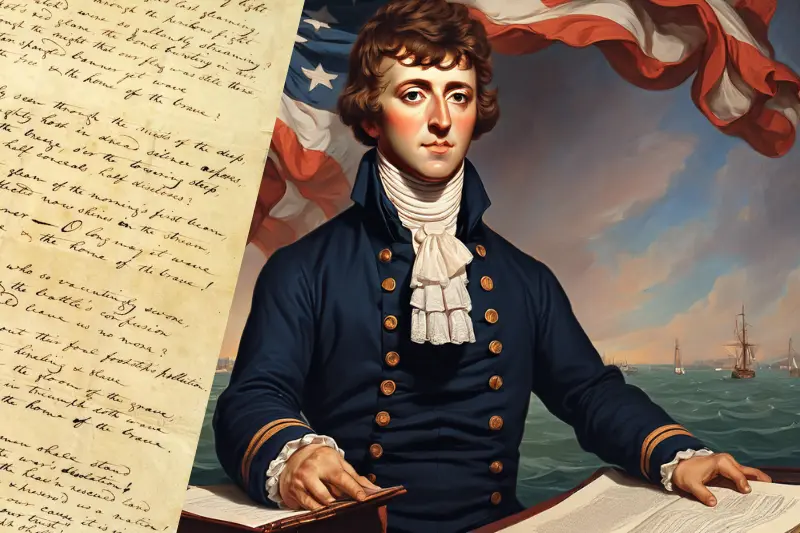Francis Scott Key: The Man Behind the National Anthem

Francis Scott Key: The Man Behind the National Anthem
Francis Scott Key, a name immortalized through the verses of “The Star-Spangled Banner,” holds a unique place in American history. While many recognize the national anthem, fewer are familiar with the man behind its creation. This post delves into the life of Francis Scott Key, exploring his background, the circumstances that led to the writing of the anthem, and his legacy.
Early Life and Education
Francis Scott Key was born on August 1, 1779, in Frederick County, Maryland. He was the son of John Ross Key, a distinguished lawyer and officer in the Continental Army, and Ann Phoebe Charlton Key. The family was well-established, which afforded young Francis a privileged upbringing. Key’s early education was at home, where he was taught by private tutors, reflecting the era’s typical education for children of affluent families.
Key later attended St. John’s College in Annapolis, Maryland, where he graduated in 1796. His time at St. John’s was formative, providing him with a classical education that included studies in literature, rhetoric, and the arts. These early academic experiences undoubtedly shaped his future literary endeavors.
Career and Family Life
After completing his education, Key pursued a career in law, following in his father’s footsteps. He established a successful practice in Georgetown, which at the time was a separate municipality within the District of Columbia. Key was known for his eloquence and legal acumen, which earned him a respectable reputation in the legal community.
In 1802, Key married Mary Tayloe Lloyd, and together they had eleven children. Despite his busy career, Key was a devoted family man. His legal work often intersected with his personal beliefs, as he was deeply religious and an active member of the Episcopal Church. His faith played a significant role in his life and influenced his perspectives on various social issues, including slavery—a topic he had complex views on, given the era’s prevailing attitudes.
The War of 1812 and the Birth of the National Anthem
The War of 1812 between the United States and Great Britain was a pivotal moment in American history, and it was during this conflict that Francis Scott Key wrote the poem that would become the national anthem. The specific events leading to the creation of “The Star-Spangled Banner” unfolded in September 1814 during the Battle of Baltimore.
Key had boarded a British ship to negotiate the release of Dr. William Beanes, a friend who had been captured by the British. During the negotiations, Key and his companions were detained by the British, as they had gained knowledge of the impending attack on Baltimore. From the deck of the British ship, Key witnessed the bombardment of Fort McHenry on the night of September 13-14, 1814.
The sight that greeted Key the following morning was awe-inspiring. Despite the relentless assault, the American flag, known as the “Star-Spangled Banner,” still flew over Fort McHenry. Moved by this powerful image of resilience and patriotism, Key penned a poem titled “Defence of Fort M’Henry.” The poem was set to the tune of a popular British song, “To Anacreon in Heaven,” and quickly gained popularity. It was later renamed “The Star-Spangled Banner.”
Literary Contributions and Legal Career
While Key is best known for writing the national anthem, his literary contributions extend beyond this single work. He wrote numerous poems and hymns, many reflecting his deep religious faith. His writings often explored themes of patriotism, morality, and spirituality.
Parallel to his literary pursuits, Key’s legal career continued to flourish. He served as the United States Attorney for the District of Columbia from 1833 to 1841, a position that allowed him to play a significant role in the legal landscape of the nation’s capital. His legal practice was diverse, ranging from criminal defense to property law. Despite his busy professional life, Key remained active in his community and church, demonstrating a commitment to public service.
Complex Views on Slavery
Key’s legacy is complicated by his views and actions regarding slavery. Although he owned slaves and represented slave owners in legal matters, he also defended the rights of free African Americans and took on cases to emancipate slaves. Key’s views on slavery evolved over time, reflecting the tensions and contradictions of the era. He was a founding member of the American Colonization Society, an organization that advocated for the relocation of freed African Americans to Africa, specifically Liberia. While this movement was controversial and viewed by some as a way to uphold the institution of slavery in America, Key saw it as a humanitarian effort.
Legacy and Memorials of The Man Behind the National Anthem
Francis Scott Key’s legacy is enshrined in the national consciousness through “The Star-Spangled Banner,” which was officially adopted as the national anthem by Congress in 1931. The song is a symbol of American perseverance and unity, often performed at public events and ceremonies.
In addition to his musical legacy, Key’s contributions are remembered through various memorials and landmarks. The Francis Scott Key Bridge in Washington, D.C., and the Key Monument in Baltimore are notable tributes to his life and work. His former home in Georgetown is preserved as a historic site, providing insight into his life and times.
Francis Scott Key The Man Behind the National Anthem was a man of many dimensions—a lawyer, poet, patriot, and family man. His creation of “The Star-Spangled Banner” captured a defining moment in American history, symbolizing the resilience and enduring spirit of the nation. While his legacy is complex, marked by his views on slavery and his legal career, Key’s contributions to American culture and history are undeniable. Through his words, the spirit of the American flag and the principles it stands for continue to inspire generations.
As we reflect on the life of Francis Scott Key, we are reminded of the power of the written word and the enduring impact of a single moment in history. His legacy, though multifaceted, remains a testament to the enduring power of patriotism and the American spirit.
Leave a comment if you liked our post Francis Scott Key: The Man Behind the National Anthem






